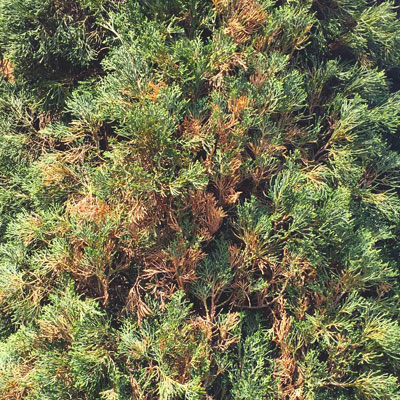Question of the Week 1: March 30, 2017
“Neil, my junipers and Italian cypress plants are dying. What is causing it and how can I stop it?”
This is critical, and time is of the essence. I have never seen a bigger outbreak of spider mites (aka “red spiders”) on junipers and Italian cypress in my 47 years of horticultural education in Texas. We are crawling with them!

Photo: This plant will be dead within a few days if spider mites aren’t brought under control.
The particular mite that is involved is ultra-tiny. I used to say that you could put 20 of them side-by-side on the head of a pin, but after showing two friends the outbreak I had found on my own little potted juniper, I would increase that to 50 or more. Seriously!
Take a heavy piece of white paper. (I took a stout piece of white mail.) Thump one of the affected twigs (gray, but not yet brown) onto the paper two or three times briskly.
Watch the paper closely. There usually are some pinhead-sized insects that move around briskly right away. Those are not the mites. Look for tiny dark specks that look like very, very fine dust. Within 10 or 15 seconds you’ll see them start to move around, and that’s when you’ll begin to feel like you need to go in and take a shower. There will be hundreds of them.
We used to have Kelthane as a dedicated miticide to kill these 8-legged pests (insects, of course, have six legs). But Kelthane is off the market, so you’ll need to find a general-purpose insecticidal spray that lists spider mites on its label. (You don’t have time to wait on a systemic insecticide to be taken up through the plant.) There will be several good options in any good independent retail garden center. Choose one, and spray it directly into the plant with a good bit of force. Coat all surfaces thoroughly.
Check the plant again in a couple of days. If you see the mites again, treat a second time. More may have hatched.
Spider mites are the most damaging pests we have in Texas landscapes and gardens. They will also attack marigolds, violets, tomatoes, beans and many other plants that we grow. Just remember this process. You’ll need it again.
